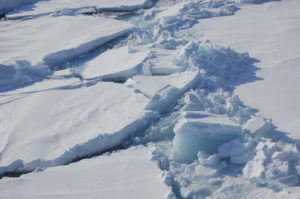
Ice floats in the Arctic near Svalbard, Norway, in April 2009. At the end of October 2016, the Arctic sea ice was at its lowest October coverage since satellite-based data records started in 1978.
The year 2016 will go down as one with below-normal Arctic sea ice coverage.
While not quite a record-setting year like 2012, throughout much of 2016 the extent of sea ice was more than two standard deviations below the average. At the end of October the Arctic sea ice was at its lowest coverage for the month since satellite-based data records started in 1978.
This continues the recent decreasing trend observed in the Arctic over the last decade. As of November, the sea ice extent remains low over much of the Arctic Sea. In addition to having a smaller extent, the Arctic is losing it thickest and oldest ice. Scientists recognize that the decrease in sea ice is directly tied to the global warming that is being driven by human activity.
The decreasing ice can enhance this warming by what is referred to as a positive feedback. Sea ice is bright and reflects about 80 percent of the sunlight that falls on it, helping to keep the surface cool. When the ice melts, the ocean surface is exposed and is able to absorb the incident solar energy. This leads to a warming of the water and the air above, which can melt more ice, leading to an increased warming and more melting.
Since the sea ice is floating on the ocean, melting it does not cause the sea level to rise. Melting ice on land will cause the sea level to rise as it contributes to increased runoff. In addition, as the ocean waters warm, they expand, which further contributes to sea level rise.

